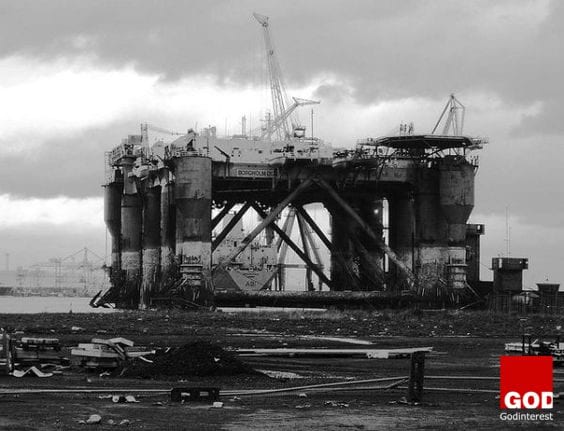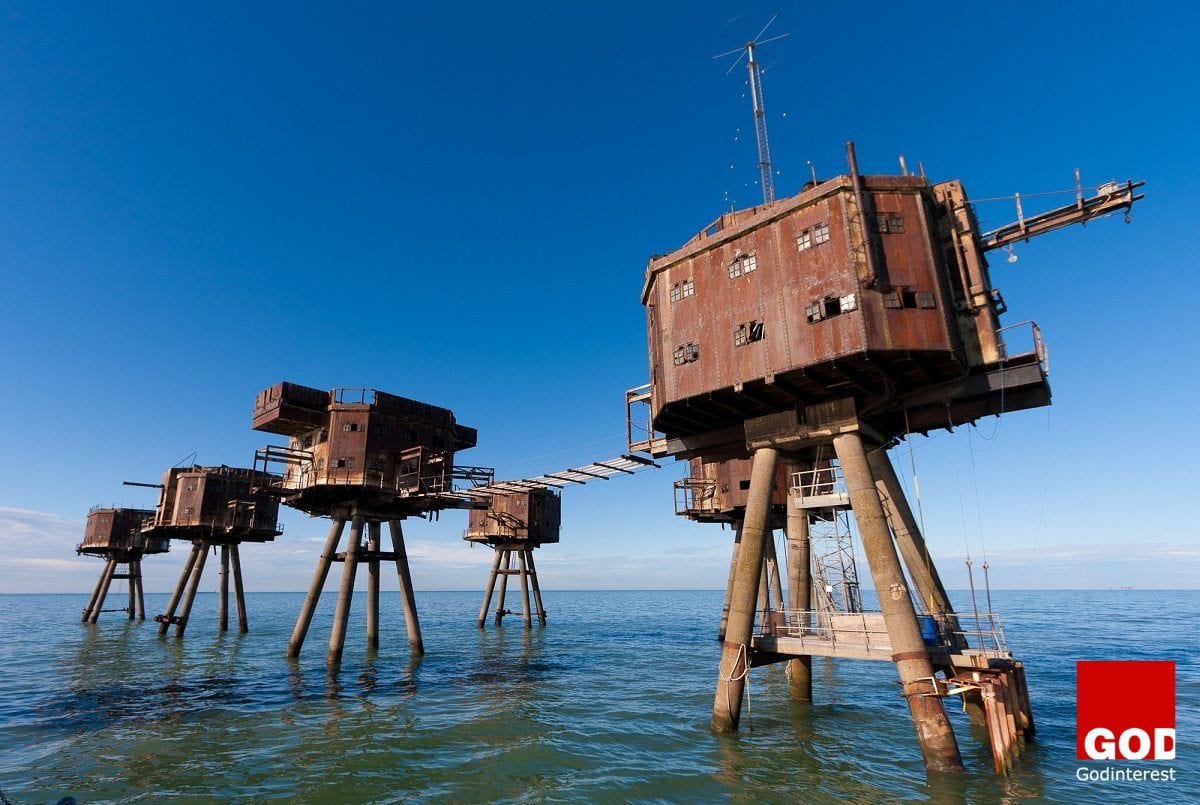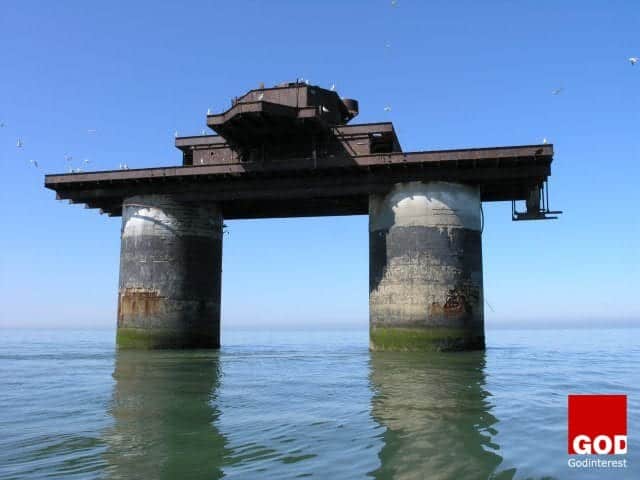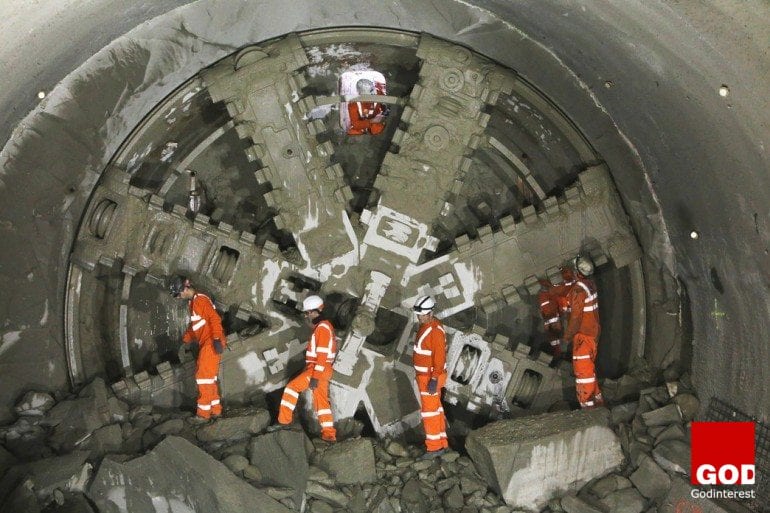Back to Eden – This Tubular Glass House Wraps Around a Single Tree
7 Astonishing Abandoned Projects” Surreal Riveted Sea Forts Once Protected the Kent Shores from German Attack”
Abandoned projects including building, engineering and infrastructure development projects litter the whole of the world.
Most of them were started to symbolise a country’s prosperity and vision but after years of abandonment, stalled development and economic crisis, some of the world’s most amazing projects have been abandoned and now have come to epitomise national struggle.
From Bangkok’s ‘Ghost Tower’ which was abandoned after the 1997 financial crisis to the Tower of David, here is a selection of some of the world’s most famous abandoned and incomplete projects in no particular order.
1. Bangkok’s ‘Ghost Tower’
On stormy days debris from this unfinished and abandoned skyscraper rains down on the streets of Bangkok
A towering waste. It’s called Bangkok’s ‘ghost tower’. This 49-storey prominent unfinished skyscraper in the Thai capital city of Bangkok was destined to be a state-of-the-art office and residential complex, but has instead become a destination for urban explorers. Planned as a high-rise condominium complex, construction of the building was halted during the 1997 Asian financial crisis when it was 80% complete.
Now the 174-meter graffiti-covered building mainly houses squatters.
2. The “Tower of David”

Torre de David (The Tower of David) named after David Brillembourg, the tower’s main investor who died in 1993 has been depicted as a haven for drug lords and assassins in the TV series Homeland, lauded as an experiment in social empowerment at the Venice Architecture Biennale and featured in countless articles and documentaries around the world. In May 2014, the tower was also featured in the BBC World News documentary, Our World.
For eight years, the Tower of David a half-built skyscraper in downtown Caracas the capital of Venezuela. was home to thousands of squatters who transformed the abandoned block into a ghetto complete with grocery shops, tattoo parlours, internet cafes and a hair salon.
Construction of the tower began in 1990 but was halted in 1994 due to the Venezuelan banking crisis. As of 2016, the building remains incomplete.
This vertical ghetto can be seen from almost every corner of this densely populated capital.
In 2014 Ernesto Villegas, the minister for the revolutionary transformation of greater Caracas, said all the tower’s residents would be relocated to “dignified homes”. “This is not an eviction, but rather a relocation,” he told reporters. Villegas said several children had fallen to their deaths from the tower, which in some places is lacking walls or windows.
The newspaper Tal Cual reported that Chinese banks were interested in buying the tower and renovating it for its original use.
3. Mothballed Oil Rig
Oil rigs definitely fall into the mega category when it comes to size.You might think of them more as structures than machines. The rig above is a accomodation platform rather than an oil drilling rig, re-built in Belfast in the late 1990s. Mothballed as opposed to completely abandoned, the rig stands alongside the derelict area of the old Harland and Wolff shipyard.
This Patch of Wasteground Is Probably One of the Most Famous in Maritime History, Being the Construction Site of the Rms Olympic and Her Sister Ship Titanic.
Today modern redevelopment is breathing new life.
“Surreal Riveted Sea Forts Once Protected the Kent Shores from German Attack”
5. Project Babylon
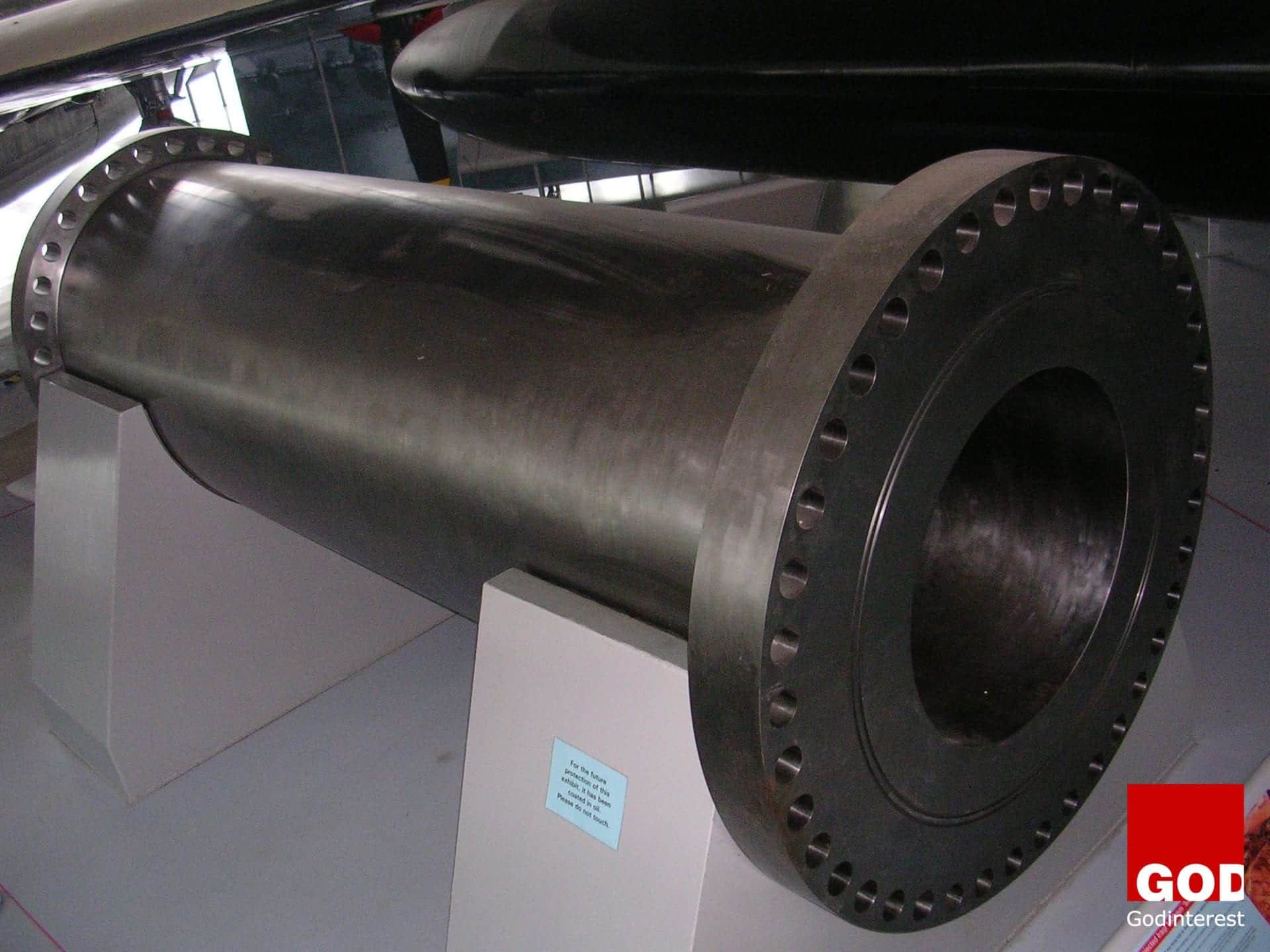
Project Babylon: The Story of Saddam’s Supergun
Project Babylon was a project with unknown objectives commissioned by the then Iraqi president Saddam Hussein to build a series of “superguns”. The Iraqi government engaged world-renowned artillery expert Gerald V. Bul whose lifetime obsession was a the construction of a “Supergun,”. The design was based on research from the 1960s Project HARP,
In early April 1990, United Kingdom customs officers confiscated several pieces of the second Big Babylon barrel, which were supposedly disguised as “petrochemical pressure vessels”. Components, such as slide bearings for Big Babylon, were seized at their manufacturers’ sites in Spain and Switzerland. After the Gulf War in 1991, Iraq confirmed the existence of Project Babylon, and permitted U.N. inspectors to destroy the hardware. A section seized by UK customs officers is on display at The Royal Artillery Museum, Woolwich, London.

The BasÃlica i Temple Expiatori de la Sagrada FamÃlia is a large Roman Catholic church in Barcelona, designed by Spanish architect Antoni Gaudà (1852–1926). Although incomplete, the church is a World Heritage Site and has been visited by the Pope. Inspired by GaudÃ’s vision, and funded almost exclusively by the millions of tourists who flock to it every year, today, the Sagrada FamÃlia is more than halfway done, with a estimated completion date of 2026. The lead architect is confident that it will be finished “ within the next century.
Has Nigeria Become the World’s Junk Yard of Abandoned and Failed Mega Projects worth Billions?
Dim1, N. U., Okorocha2, K. A., & Okoduwa3 V. O.
The Nigerian construction industry is mostly concerned with the development and provision of projects such as roads, bridges, railways, residential and commercial real estates, and the maintenance necessary for the socio-economic developments contributes immensely to the Nigerian economic growth (Bureau of Statistics, 2015). Butcher and demmers (2003) described projects as an idea which begins and ends by filling a need. However, a project fails when its idea ends without meeting the needs and expectations of its stakeholders.
Nigeria Has Become the World’s Junk – Yard of Abandoned and Failed Projects worth Billions of Naira!
Hanachor (2013), revealed that projects form part of the basis for assessing a country’s development. However, a damming report from the Abandoned Projects Audit Commission which was set up by the Ex-President Goodluck Jonathan in 2011 revealed that 11,886 federal government projects were abandoned in the past 40 years across Nigerian (Abimbola, 2012). This confirmed the assertion by Osemenan (1987) “that Nigeria has become the world’s junk –yard of abandoned and failed projects worth billions of naira”.
Abandoned projects including building and other civil engineering infrastructure development projects now litter the whole of Nigeria.
Physical projects do not only provide the means of making life more meaningful for members of the community where the projects are located, successful projects also result in empowerment and collective action towards self improvement (Hanachor, 2013).
This Issue of Abandonment Has Been Left Without Adequate Attention for Too Long, and Is Now Having a Multiplier Effect on the Construction Industry in Particular and the Nigeria’s National Economy as a Whole. (Kotngora, 1993)
PROJECT FAILURE
Project Failure might mean a different thing to different stakeholders. A project that seemed successful to one stakeholder may be a total failure to another (Toor and Ogunlana, 2008). Some stakeholders, more especially the project users and some private owners, think of failed projects as a situation where a completed building project collapsed, a situation where by a completed dam project stopped working after few days of completion, or a completed road project that broke down after few months of completion. Other experienced stakeholders, such as engineers and architects conform to the iron triangle by Atkinson (1999) which states that the most strategically important measures of project failure are “time overrun”, “cost overrun”, and “poor quality”.
Turner (1993) noted that a project fails when the project specifications are not delivered within budget and on time; the project fails to achieve its stated business purpose; the project did not meet the pre-stated objectives; the project fails to satisfy the needs of the project team and supporters; and the project fails to satisfy the need of the users and other stakeholders. Lim and Mohamed (1999) cited in Toor and Ogunlana (2009) clarified that there are two possible view points to project failure namely; the macro-level and the micro-level. They further explained that the macro view point reviews if the original objectives and concepts of the project was met. Usually the end users and the project beneficiaries are the ones looking at the project failure from the macro view point, where as the project design team, the consultants, contractors, and suppliers review projects from a micro view point focusing on time of delivery, budget, and poor quality.
In the early 1990s, the failure as well as the success of any project was determined by the project duration, monetary cost, and the performance of the project (Idrus, Sodangi, and Husin, 2011). Belout and Gauvrean (2004), also confirmed that the project management triangle based on schedule, cost, and technical performance is the most useful in determining the failure of a project. Moreover, a project is considered as an achievement of specific objectives, which involves series of activities and tasks which consume resources, are completed within specifications, and have a definite start and end time (Muns and Bjeirmi 1996, cited in Toor and Ogunlana, 2009). Reiss (1993) in his suggestion stated that a project is a human activity that achieves a clear objective against a time scale. Wright (1997) taking the view of clients, suggested that time and budget are the only two important parameters of a project which determines if a project is successful or failed. Nevertheless, many other writers such as Turner, Morris and Hough, wateridge, dewit, McCoy, Pinto and Slevin, saarinen and Ballantine all cited in Atkinson (1999), agreed that cost, time, and quality are all success as well as failure criteria of a project, and are not to be used exclusively.
FACTORS OF PROJECT FAILURE
Cookie-Davies (2002) stated the difference between the success criteria and the failure factors. He stated that failure factors are those which contributed towards the failure of a project while success criteria are the measures by which the failure of a project will be judged. The factors constituting the failure criteria are commonly referred to as the key performance indicators (KPIs).
Time and Cost Overrun
The time factor of project failure cannot be discussed without mentioning cost. This is because the time spent on construction projects has a cost attached to it. Al-Khali and Al-Ghafly, (1999); Aibinu and Jagboro, (2002) confirmed that time overrun in construction projects do not only result in cost overrun and poor quality but also result in greater disputes, abandonment and protracted litigation by the project parties. Therefore, focus on reducing the Time overrun helps to reduce resource spent on heavy litigation processes in the construction industry (Phua and Rowlinson, 2003). Most times, the time overrun of a project does not allow resultant system and benefits of the project to be taking into consideration (Atkinson, 1999). Once a project exceeds the contract time, it does not matter anymore if the project was finally abandoned or completed at the same cost and quality specified on the original contract document, the project has failed. Furthermore, Assaf and Al-Hejji, (2006) noted that time overrun means loss of owner’s revenue due to unavailability of the commercial facilities on time, and contractors may also suffers from higher over heads, material and labour costs.
Poor quality/Technical Performance
The word “Performance” has a different meaning which depends on the context it is being used and it can also be referred to as quality. Performance can be generally defined as effectiveness (doing the right thing), and efficiency (doing it right) (Idrus and Sodangi, 2010). Based on this definition of performance, at the project level, it simply means that a completed project meets fulfilled the stakeholder requirements in the business case.
CAUSES OF PROJECT FAILURE
A lot of research studies have investigated the reasons for project failures, and why projects continue to be described as failing despite improved management. Odeh and Baltaineh, 2002; Arain and Law, 2003; Abdul-Rahman et al., 2006; Sambasivan and Soon, 2007; all cited in Toor and Ogunlana, 2008, pointed out the major causes of project failures as Inadequate procurement method; poor funding and availability of resources; descripancies between design and construction; lack of project management practices; and communication lapses
The contract/procurement method
A result obtained from two construction projects which were done by the same contractor but using different procurement methods showed that rework, on the design part which occurs when the activities and materials order are different from those specified on the original contract document, makes it difficult for the project to finish on the expected time (Idrus, Sodangi, and Husin, 2011). This is as a result of non-collaboration and integration between the design team, contractor, and tier suppliers. The rework on the design portion has a huge impact on project failure leading to the time overrun. The traditional method of procurement has inadequate flexibility required to facilitate late changes to the project design once the design phase of the construction project has been concluded.
Nigerian most widely used procurement method is the traditional method of procurement (design-bid-construct) which has been confirmed to be less effective to successfully delivery of a construction project (Dim and Ezeabasili, 2015). And, the world bank country procurement assessment report (2000) cited in Anigbogu and Shwarka, (2011) reported that about 50% of projects in Nigeria are dead even before they commence because they were designed to fail.
The way the construction projects are contracted, in addition to the way the contracts are delivered, contributes to the causes of projects failure. Particularly, among the methods of project contracting is lump-sum or a fixed-price contracting method, in which the contractor agrees to deliver a construction project at a fixed price. The fixed-price contract can be low-bid or not however, once the contract cost has been agreed upon the contract award, it cannot be changed. And, contractors are expected to honor and deliver the contract agreement, failure to do so can result in a breach of contract which can result in the contractor being prosecuted.
Awarding a contract to an unqualified personnel also contributes to project failures. When a contractor places more emphasis on money and the mobilization fee after a construction project has been initiated instead of getting the right workforce and skilled professionals that will execute the project. Instead the workforce chosen will often not be base on competence and required skills rather it will be based on availability. Moreover, poor strategy and planning by contractors who have overloaded with work also contributed to one of the causes of project failure.
Poor funding/Budget Planning
A lot of public projects in the Nigerian construction industry failed as a result inadequate funding, and the difference between the national annual budget and the budget actual released. Most of the Nigerian public projects are signed even before the actual release of the national budget. The difference in budget of the contracted project and the actual budget release can get the contracted company stuck as a result of inflation of prices, scarcity of construction material at the time of the budget release and mobilization to site. Also un-planned scope of work which can be as a result of the contractor working on another contract when he is called back to mobilization to start work. Moreover, poor budget planning is a regular mistake made by some contractors by not undertaking feasibility assessments before starting the design. The construction project should be planned according to the available resources and not according to the unrealistic expectations a client has in mind.
Discrepancies Between the Design and Construction
Limited collaboration between the contractors, engineers, and the architect results in discrepancies between the project designs and construction on site, and further leads to rework. Changes on a project designs, and changing to the scope of work in the middle of construction processes on site can be dangerous, and can lead to time overrun, increase in cost, and most of all can lead to abandonment. Moreover, many cases have been seen where the designs from the architects are not buildable on site, while In some cases, most contractors are unable to adequately specify the scope of work for the construction processes on site. Therefore any default on the design by the architect can be an opportunity for the contractor to make more money which might cause the project duration to exceed the time specified on the contract document.
RESEARCH METHODOLOGY
This research starts with a general reasoning or theory which says that the major cases of project failure in the Nigerian construction industry are defined based on time overrun and cost overrun. The findings from the data analysis will help on the decision to accept the theory or not. The research data was collected from the progress report for the month ending of October, 2015 published by the Nigeria of Federal Ministry of works on thirty-nine on-going highway construction projects at the South-South geopolitical zone. The table 1 below shows the information on the data collected which comprises of the project title, contract Number, project description, the contractor that was awarded the projects, the date of project commencement, date of completion and the extended date if any. The scheduled time for each project was specified as follows: project commencement date labeled as “a”, project completion date labeled as “b”, and the extended date labeled as “c”.


DATA ANALYSIS
The data analysis was done with the use of Microsoft excel. The analysis started by obtaining the number of days between the date of commencement of each project and the date of completion to show the duration of each highway project. And, the number of days between the project completion date and the extension date showed the time-overrun. The project duration and the extended days were obtained with the use of NETWORKDAYS function in Microsoft Excel which calculates the number of working days between two dates excluding weekends and any dates identified as holidays.
The standard deviation between the specified project duration for each highway projects and the extended days was calculated to obtain the extent to which each highway project contract failed on its time of delivery. This was denoted as the degree of failure. The table 1 above showed the projects ranking which was done based on the degree of failure of all the highway projects. The highway projects that were ranked from one to sixteen have low degree of failure and are represented with green color, while the rest are those with high degree of failure and are represented with red color.
FINDINGS
The findings made showed that the successfully completed highway projects have no extended days or time overrun, and the successful on-going highway projects are still on schedule and have no extended days unlike the on-going highway projects that have already failed as a result of the extended dates. Other projects have been abandoned because they have exceeded the delivery date as specified on the contract document, and have no extended date of completion. Thus, no work is going on.


Figure 2 above showed that 14% of highway projects are still on-going projects because they have not exceeded the original date of completion as specified on the contract document. However, they are heading towards failure because they have been given an extended date of completion which can be as a result of some critical activities running behind schedule, causing delay on the critical path network of the projects. Moreover, the other 86% completely failed because they have exceeded their completion date specified on the contract document.

The figure 3 above showed that 63% of the successful highway projects are still on-going because they have not exceed their completion dates, and they are not yet completed. However, those on-going highway projects might end up as failed projects as a result of poor funding, discrepancy between the design and the construction on site, and conflict between the construction parties or stakeholders.
“Say what you will do, and do what you said” or “Say as you will do it, and do it as you said”
CONCLUSION AND RECOMMENDATION
The idea of knowing what a failed project is, the factors and the causes is very important in project management. Success in project management can neither be achieved nor measured without the knowledge of project failure, its factors, and causes in the Nigerian construction industries. This work has shown that project failure is as a result of exceeded time of delivery, cost overrun, and poor quality. However, the analysis was only done based on exceeded time of project delivery because of the nature of the data collected.
This work suggested a few approaches to help reduce the number of failed projects in the Nigerian construction industry if properly implemented. Firstly, Having good collaboration between the project stakeholders involved in a construction project at the early stage of project conception is most important in order to accomplish the project objectives, and deliver the project on time, within budget, and quality specified on the original contract document (Othman, 2006).
Secondly, Adopting the ISO 9000 technique which is used for quality management will also help in achieving a successful project delivery. This technique states “ say what you will do, and do what you said” or “say as you will do it, and do it as you said”. This technique is not an indication of high quality but it promotes control and consistency which leads to specialization, and improved productivity and quality. Also, adopting the principles of lean construction will help to reduce waste within the construction and stream-line activities in order to improve the on-time delivery of projects.
Thirdly, Learning from the precedent failed projects, how those projects failed, and the reason for their failures. This will help the project manager to plan and mitigate the risks of project failures in the future. And, finally, more seminars and workshops will help to educate and enlighten clients (the federal government representatives), users, contractors, engineers, and architects on what is project failure, the factors that contributes to abundant failed projects, and their causes.
REFERENCE
Abimbola, A. (Novermber 24, 2012). About 12,000 Federal Projects Abandoned across Nigeria. Premium times (November 16, 2015). Retrieved from www. Premium timesng.com/news/108450-about-12000-federal-projects-abandoned-across-nigeria.html.
Al-Khali, M.I and Al-Ghafly, M.A. (1999). Important Causes of Delays in Public Utility Projects in Saudi Arabia. Construction management and Economics, 17, 647-655
Aibinu, A.A and Jagboro, G.O. (2002). The Effects of Construction Delays on Project Delivery in Nigeria Construction Industry. International journal of Project management, 20(8), 593- 599.
Anigbogu, N. and Shwarka, M. (2011). Evaluation of Impact of the Public Procurement Reform Program on Combating Corruption Practices in Public Building Project Delivery in Nigeria. Environtech Journal, 1(2). 43-51.
Assaf, S. and Al-Hajji, S. (2006). Causes of Delays in large Construction Projects. International Journal of Project Management, 24, 349-357.
Atkinson , R. (1999). Project management: Cost, time, and quality, two best guesses and a Phenomenon, it’s time to accept other success criteria. International Journal of project Management, 17(6), 337-342.
Belout, A and Gauvrean, C. (2004). Factors Influencing the Project Success: The impact of human resource management. International Journal of project Management, 22, Pp. 1-11.
Butcher, N. and Demmers, L. (2003). Cost Estiumating Simplified. Retrieved from www.librisdesign.org.
Cookie-Davies, T. (2002). The Real Success Factors on Projects. International Journal of Project management, 20(3), 185-190.
Dim, N.U. and Ezeabasili, A.C.C (2015). Strategic Supply Chain Framework as an Effective Approach to Procurement of Public Construction Projects in Nigeria. International Journal of Management and Susutainability, 4(7), 163-172.
Hanachor, M. E. (2012). Community Development Projects Abandonment in Nigeria: Causes and Effects. Journal of Education and Practice, 3(6), 33-36.
Idrus, A., Sodangi, M., and Husin, M., H. (2011). Prioritizing project performance criteria within client perspective. Research Journal of Applied Science, Engineering and Technology, 3(10), 1142-1151.
Idrus, A. and Sodangi, M. (2010). Framework for evaluating quality performance of contractors in Nigeria. International Journal of Civil Environment and Engineering. 10(1), 34-39.
National Bureau of Statistics (January, 2015). Nigerian Construction Sector Summary Report: 2010-2012.
Kotangora, O. O. (1993). Project abandonment, Nigerian Tribune.
Osemenan, I. (1987). Project Abandonment. New Watch Magazine, Vol. 1, pp. 15.
Othman, M.,R. (2006). Forging main and sub-contractor relationship for successful projects. Retrieved from http://rakanl.jkr.gov.my/csfj/editor/files/file/projek/lessonslearned/MAIN&SUB_2.pdf
Phua, F.T.T and Rowlinson, S. (2003). Cultural Differences as an Explanatory Variable for Adversarial Attitude in the Construction Industry: The case of HongKong. Construction Management and Economics, 21, 777-785.
Reiss, B. (1993). Project Management Demystified. London: E and FN Spon Publishers.
Toor, S. R. and Ogunlana, S. O. (2008).Problems causing Delay in Major Construction Projects in Thailand. Construction management and Economics, 26, 395-408.
Toor, S. R. and Ogunlana, S. O. (2008). Critical COMs of Success in Large-Scale Construction Projects: Evidence from Thailand constructuction industry. International Journal of Project management, 26(4), 420-430.
Toor, S. R. and Ogunlana, S. O. (2009).Beyound the “Iron Triangle”: Stakeholder perception of key performance indicators (KPIs) for large-scale public sector development projects. International Journal of Project management, doi: 10.1016/j.ijproman.2009.05.005.
Toor, R. and Ogunlana, S. (2009). Construction Innovation: Information, process, management. 9(2), PP. 149-167.
Turner, J. R. (1993). The Handbook of project-Based Management: Improving the process for achieving strategic objective. London, McGraw-Hill.
Wright, J., N. (1997). Time and Budget: The twin imperatives of a project Sponsor. International Journal of Project Management, 15(3), 181-186.
Heathrow Airport Expansion – Exploring the Controversy
LONDON – The debate over the £19 billion scheme for the third runway at Heathrow airport has been a long-running row which has grown into fierce opposition within the last couple of months.
We shall not be moved, Heathrow Airport management has stuck to its original course of action, while ignoring constant protests and public discontent and insists that expanding Heathrow will provide the growth, jobs, experts, and connections to make Great Britain greater still.
Sir Richard Branson Urges Heathrow Expansion, and Says “Britain Is ‘being Held Back Massively”.
The billionaire founder of the Virgin Group has accused politicians of neglecting to back the expansion project at Heathrow because they are more concerned about their own jobs rather than doing “what is right for the UK”.
The entrepreneur, Sir Richard Branson urged the Government to be ” bold and brave on big infrastructure decisions like this”.
Hounslow Council, on the other hand, has been accused of “throwing in the towel” over the Heathrow expansion after it promoted the “opportunity of a third runway”. In response, Hounslow Council leader Steve Curran stated its stance on Heathrow had not changed but said it needed to be prepared if the government approves the recommendation for a third runway later this year.
Meanwhile, twelfth century St Mary the Virgin sits right in the middle of flight paths in the village of Harmondsworth, Middlesex and under blueprints for the expansion of the airport, most of the buildings in the village will be demolished but the 951-year-old grade II listed church will be spared. Protesters say there would no longer be anyone to use it.
Amid mounting concerns and opposition from the whole community Justine Greening, the International Development Secretary predicts the government will ditch the £16bn plan for a third runway at Heathrow.
“Trying to Expand Heathrow Is like Trying to Build an Eight Bedroom Mansion on the Site of a Terraced House. It Is a Hub Airport That Is Just Simply in the Wrong Place” – Justine Greening
London Mayor Boris Johnson has been a vehement opponent of Heathrow expansion and has said
that the New Heathrow runway will negatively affect public health. In his report ‘Landing the Right Airport’ presented in March, Boris Johnson evaluated damages caused by the new runway to be between £20bn to £25bn during the next 60 years.
Both Zac Goldsmith and Sadiq Khan, respective Conservative and Labour candidates to succeed Mr. Johnson are also on the bandwagon and are campaigning against a third runway. This controversial debate has also resulted in Downing Street issuing an instruction to ministers asking them not to discuss the proposed third runway at Heathrow airport.
The North West Runway Will Be Two Miles (3,200m) Long, Making It Big Enough for Any Aircraft in the World to Use It
The commission, which was ordered by the government coalition, stated that the Heathrow expansion is ‘the best answer’ to easing the pressure on the UK’s crowded air terminals and that it will not increase noise above current levels, but will generate up to £147 billion in GDP impacts over 60 years.
Furthermore, if the plan for the third runway is approved, it will provide 740,000 flights a year, putting it on equal footing with Paris, Frankfurt, and Amsterdam.
A decision on whether to build a third runway at Heathrow Airport has been delayed until summer 2016, the government has confirmed.
33 of the Most Inspirational Leadership Quotes for You to Live By
We’ve all seen quotes designed to motivate or inspire us. Well, according to a new study, people who post these ‘inspirational’ quotes also have lower levels of intelligence. However, Godinterest disagrees, and see’s some quotes as universal nuggets of wisdom. You know the ones – those quotes that give you “Aha!” moments of inspiration or meaningful insights into your personal and professional lives. These are the ones you want to print out and place on your fridge so you’ll see them every day.
This collection of inspirational quotes features some of the all-time classics you may know, as well as some lesser-known ones you’ll love too. If you have any quotes you would have added, feel free to share in the comments section!
- “The reason most people never reach their goals is that they don’t define them, or ever seriously consider them as believable or achievable.” – Denis Watley
- “Our goals can only be reached through a vehicle of a plan, in which we must fervently believe, and upon which we must vigorously act. There is no other route to success.” – Stephen A. Brennan
- “Without goals, and plans to reach them, you are like a ship that has set sail with no destination.” – Fitzhugh Dodson
- “Goals are dreams with deadlines.” – Diana Scharf Hunt
- “You must have long-term goals to keep you from being frustrated by short-term failures.” – Charles C. Noble
- “Crystallize your goals. Make a plan for achieving them and set yourself a deadline. Then, with supreme confidence, determination, and disregard for obstacles and other people’s criticisms, carry out your plan.” – Paul Meyer
- “The tragedy of life doesn’t lie in not reaching your goal. The tragedy lies in having no goals to reach.” – Benjamin Mays
- “Progress has little to do with speed, but much to do with direction.” – Unknown
- “The world makes way for the man who knows where he is going.” – Ralph Waldo Emerson
- “Goals help focus you on areas in both your personal and professional life that are important and meaningful, rather than being guided by what other people want you to be, do, or accomplish.” – Catherine Pulsifer
- “What you get by achieving your goals is not as important as what you become by achieving your goals.” – Zig Ziglar
- “It doesn’t matter where you are coming from. All that matters is where you are going.” – Brian Tracy
- “The true measure of a man is not how he behaves in moments of comfort and convenience but how he stands at times of controversy and challenges.” – Martin Luther King Jr.
- “It’s not the load that breaks you down, it’s the way you carry it.” – Horne, Lena
- “Difficulties are meant to rouse, not discourage. The human spirit is to grow strong by conflict.” – William E. Channing
- “Nothing is particularly hard if you divide it into small jobs.” – Henry Ford
- “It’s not whether you get knocked down. It’s whether you get up again.” – Vince Lombardi
- “You must do the thing you think you cannot do.” E- Eleanor Roosevelt
- “Motivation is what gets you started. Habit is what keeps you going.” – Jim Ryun
- “Strong lives are motivated by dynamic purposes.” – Kenneth Hildebrand
- “People who are unable to motivate themselves must be content with mediocrity, no matter how impressive their other talents.” – Andrew Carnegie
- “Be miserable. Or motivate yourself. Whatever has to be done, it’s always your choice.” – Wayne Dyer
- “The surest way not to fail is to be determined to succeed.” – Richard B. Sheridan
- “A determined person will do more with a pen and paper than a lazy person will accomplish with a personal computer.” – Catherine Pulsifer
- “There is no chance, no destiny, no fate, that can hinder or control the firm resolve of a determined soul.” – Ella Wheeler Wilcox
- “It was courage, faith, endurance and a dogged determination to surmount all obstacles that built this bridge.” – John J. Watson
- “Failure will never overtake me if my determination to succeed is strong enough.” – Og Mandino
- “You’ve got to get up every morning with determination if you’re going to go to bed with satisfaction.” – George Lorimer
- “We will either find a way or make one!” – Hannibal
- “That some achieve great success, is proof to all that others can achieve it as well.” – Unknown
- “Do not let what you cannot do interfere with what you can do.” – John Wooden
- “Success seems to be largely a matter of hanging on after others have let go.” – William Feather
- “Success is the sum of small efforts, repeated day in and day out.” – Robert Collier
The Garden Bridge Project, London

Thomas Heatherwick’s Garden Bridge has moved one step closer to reality with the appointment of building contractors Bouygues Travaux Publics and Cimolai. Building work is now scheduled to start this summer 2016, but opponents and locals are still not convinced.
Why Is London’s Garden Bridge worth as Much as Five Lancashire Museums? Ask’s Joanna Lumley
The Opponents
For those of you who aren’t aware of the project, it’s intended to be a plant-covered pedestrian bridge across the River Thames between the South Bank and Temple. The Bridge was designed by Heatherwick after being conceived by British actress Joanna Lumley.
Coined as a “wondrous green oasis floating above the River Thames”, the £175m 367-metre-long Garden Bridge, backed by London mayor Boris Johnson, has sparked a huge amount of controversy in London with calls for the project to be halted from a number of local politicians. This includes Vauxhall MP Kate Hoey and three councillors from the London Borough of Lambeth, even though planning permission was granted by both local authorities in late 2014.
Writing in the Guardian, Ian Jack contrasted the £60m taxpayer support for the project with the closure of five Lancashire museums – two of the which are nationally important and forty libraries. Jack described the bridge as unwanted and unnecessary and the closures as “cultural disembowelment.
In November 2014, it was claimed that the bridge would be off limits to groups of eight or more people and cyclists, and closed between midnight and 6am. Critiques fear that the £175m bridge, which already has £60m in official grants and loans, will require a bailout if costs rise or efforts to drum up further private money fail.
Halt London Garden Bridge Project, Says RIBA President
An study by The Architect’s Journal found that Heatherwick was present for at least five meetings with London’s mayor Boris Johnson prior to the contest. The AJ also claimed that a manager for government body Transport for London (TfL) had reported anomalies in the design competition.
“It’s Now Abundantly Clear That the Design Competition That Transport for London Held in Early 2013 Was Nothing of the Sort,” Aj Deputy Editor Will Hurst Told Dezeen
Kate Hoey, the Labour MP whose Vauxhall constituency is on the south side of the bridge, has said “it is quite clear they haven’t raised nearly as much money as they originally thought.” However, The Garden Bridge Trust which was launched on 1 November 2013 to oversee the project argued that its perfectly ordinary for large infrastructure projects to begin work while fundraising determinations continue, however, in Project Journal’s experience such ambitious construction projects commonly overrun in terms of budget and time. For example, an extension to the Tate Modern art gallery was scheduled to open in 2012 at a cost of £215m. It will instead open this year at an estimated cost of £260m.
The Garden Bridge Trust has now raised an additional £85 million.
The Project
The Garden Bridge project began as a seamlessly innocent idea, a beautiful new garden floating above the River Thames, sounds amazing. Imagine crossing a river surrounded by wildlife in the middle of London City. Imagine a morning commute through a peaceful garden. Well, the Garden Bridge Trust intends to make this a reality. However, who will benefit the most, the rich, middle class, or the poor?
The bridge is planned to be 30 metres (98 ft) across at its widest point. It would run from the roof of Temple station as a continuation of Arundel Street on the north bank to Queen’s Walk by the London Studios, where a large public green open space would be redeveloped to provide a commercial building associated with the project. The bridge will feature trees, shrubs, and wildflowers. Its construction would require 32 mature trees in the avenue on Queen’s Walk, on the South Bank.
“The Garden Bridge Will Be an Extraordinarily Special Place, Either to Race Across, Relax in or Look Back at the Rest of the City’s Sights.” Thomas Heatherwick
The bridge is officially scheduled to open late 2018. Hoey said it would be “particularly inexcusable” for any more public money to be committed when her constituency was struggling under government cuts.
If you’re wondering why the bridge is being built in the first place, or why Jane Duncan is asking for the project to be terminated, read Ian Jack’s opinion piece ‘Why is London’s Garden Bridge worth as much as five Lancashire museums? Ask Joanna Lumley’ a particularly powerful and unforgiving piece, and for us, the truth.
15 Shocking Project Management Statistics
The project management landscape is changing with an increased emphasis on productivity, reporting, and information technology. A number of studies have been completed that look into the success and failure rates of projects.
Below are 15 shocking statistics that reveal how project management has changed and is performing across various industries over the last 5 years.
- There is projected to be 15.7 million new project management roles to be added globally across seven project-intensive industries by 2020 reaching an economic impact of over $18 trillion, across seven project-intensive industries including Manufacturing, Finance & Insurance, Information Services, Utilities, Business Services, Oil & Gas and Construction (Project Management Institute)
- 75% of IT executives believe their projects are “doomed from the start. (Geneca)
- The healthcare industry is projected to increase project management roles by 30%, a higher growth rate than any current project intensive industry between 2010 and 2020. (Project Management Institute)
- A third of all projects were successfully completed on time and on budget over the past year. (Standish Group)
- 80% of “high-performing” projects are led by a certified project manager. (PricewaterhouseCoopers, Insights and Trends: Current Programme and Project Management Practices 2012)
- One in six IT projects have an average cost overrun of 200%. (Harvard Business Review 2004)
- 44% of project managers use no software, even though PWC found that the use of commercially available PM software increases performance and satisfaction. (Pricewaterhouse Coopers)
- More than 90% of organizations perform some type of project postmortem or closeout retrospective. (The Standish Group: CHAOS Research Report 2013)
- On average, it takes 7 years in the profession to go from entry-level to managing large, complex projects. (ESI International: Annual Salary Survey 2013)
- The average large IT project runs 45% over budget, 7% over time, and delivers 56% less value than expected. (Project Management Institute: Pulse of the Profession 2015)
- Only 64% of projects meet their goals. (Project Management Institute: Pulse of the Profession 2015)
- 60% of companies don’t measure ROI on projects. (KPMG New Zealand: Project Management Survey 2010)
- The United States economy loses $50-$150 billion per year due to failed IT projects. (Gallup Business Review)
- In just a 12 month period 49% of organizations had suffered a recent project failure. In the same period only 2% of organizations reported that all of their projects achieved the desired benefits. 86% of organizations reported a shortfall of at least 25% of targeted benefits across their portfolio of projects and many organizations failed to measure benefits so they are unaware of their true status in terms of benefits realization. (KPMG – Global IT Project Management Survey 2005)
- According to an IBM study, only 40% of projects meet schedule, budget and quality goals. (Harvard Business Review 2004)
If you have any other project management statistics please share them with us.
Raines Court, Hackney
Protected from the weather and supported by industrial control systems, factories can produce a range of components from simple panels to fully fitted-out modules which are ready to be assembled on site. And here is where the arguments start: advantages include more consistent working conditions and therefore better quality of performance and finishes, less wastage of materials, fewer journeys to site, less disruption of the local neighbourhood, faster construction times, better health and safety. These are some of the benefits which factory built homes can bring.
“If we don’t keep investigating prefab, we risk squandering a lot of resources and not delivering enough housing.” says Andy Matthews of architect Proctor & Matthews.

An extended experiment into the potential for delivering high-quality housing through off-site construction methods Raines Court is one of the largest prefabricated schemes built to date in the UK. Raines Court consists of 61 shared ownership flats (11×3-bed, 41×2-bed, 1×1-bed plus 8 x live/work units) for public sector key workers and local people in Hackney on moderate incomes on the site of the former dairy products distribution yard on Northwold Road, Stoke Newington. The main components are modular units complete with fixtures and fittings, tiling, bathrooms, kitchens, heating, transported by lorry from York and craned into position. With its steel-framed modules, zinc-clad façade and splashes of vivid colour, Raines Court wears its modular form proudly.
Public opinion is divided on its success as a result of this but it has won several architectural awards and there is no doubting the generous layout and provision of the flats.
At six-storeys in a largely low-rise neighbourhood, the scheme is a radical, bold insertion that establishes a civic presence.
This estate was the second Peabody development constructed using prefabricated modules manufactured and was completed in 2003.
Client: Peabody Trust
Architect: AHMM
Structural Engineer: whitbybird
Contractor: Wates
Principal Supplier: Yorkon
Completion: 2003
Cost: £8.9 Million
Awards:
British construction Industry Awards: Best Practice 2004
Housing Design Award 2004
RIBA Award for Architecture 2004
Housing Design Award 2001
Housing Forum Demonstration Project 2001
7 Tips You Need to Be a Super Project Manager
You Were Never Made to Be ‘Productive’
Compared to people in other industrialized nations, Americans work longer hours, take fewer vacation days, and retire later in life. Busyness, once seen as the curse of the disadvantaged, has become equated with status and importance. Our work increasingly defines who we are.
“Godly rest (distinct from play, relaxation, or sleep) is inextricably tied to our identity as children of God.”
The solution perhaps is to be “Lazy Intelligent”? That sounds like something an unsuccessful, lazy slacker would say, isn’t it? Actually, it’s the opposite. One of America’s most influential and controversial science fiction authors Robert Heinlein uttered these words during his time. Despite his nod to laziness, Heinlein went on to pen hit titles such as Starship Troopers and Stranger in a Strange Land.
Productive laziness is not about doing absolutely nothing at all. It’s not about just sitting around and drinking coffee or engaging in idle gossip while watching the non-delivered project milestones disappear into the horizon. In fact, this behavior would lead to a very short-lived project management career.
Laziness Is Not Synonymous with Stupidity
Instead, productive laziness should be viewed as a more focused approach to management. Adopting this mindset means concentrating efforts where it really matters, rather than spreading yourself thing over unimportant, non-critical activities that in some cases don’t need to be addressed at all.
According to the Pareto Principle — Also Known as the “80/20 Rule” — 80 Percent of the Consequences Stem from 20 Percent of the Causes.
While the idea has a rule-of-thumb application, it’s also commonly misused. For example, just because one solution fits 80 percent of cases, that doesn’t mean it only requires 20 percent of the resources needed to solve all cases.
The principle, suggested by management thinker Joseph M. Juran, was named after Italian economist Vilfredo Pareto, who observed that 80 percent of property in Italy was owned by 20 percent of the population. As a result, it was assumed that most of the result in any situation was determined by a small number of causes.
Rest Is at the Center of God’s Design
Every smart but lazy person should consider the 80/20 Rule each day. For managers, the principle is a reminder to concentrate on the 20 percent of work that really matters.
Contrary to belief, 80 percent of success is not just showing up. In fact, only 20 percent of what you do during the day will produce 80 percent of your results. Therefore, it is important to identify and focus on that 20 percent during the working day.
When genius and laziness meet, the results can be magical. Being just the right combination of smart and lazy can bring you to have a real edge over others. Interestingly enough, smart lazy people are generally better suited for leadership roles in organizations. These people make great strategic thinkers and leaders. They do things in a smart way in order to expend the least effort. They don’t rush into things, taking that little bit of extra time to think and find the shortest, best path.
They question, contradict, and show dissent against inefficient methods or unnecessary tasks.
“Whenever There Is a Hard Job to Be Done, I Assign It to a Lazy Man; He Is Sure to Find an Easy Way of Doing It. — Bill Gates”
Bill’s not the only guy, who believes that laziness doesn’t necessarily have to be a bad thing. German Generalfeldmarschall Helmuth Karl Bernhard Graf von Moltke was the chief of staff for the Prussian Army for 30 years. He is regarded as one of the greatest strategists of the latter 1800s among historical scholars and is the creator of the more modern method of directing armies in the field.
Moltke observed his troops and categorized them based on their intelligence, diligence and laziness. If soldiers proved to be both lazy and smart, they were promoted to leadership because they knew how to be successful with efficiency. If soldiers were smart and diligent, they were deployed into a staff function, focusing on the details. Soldiers who were not smart and lazy were left alone in hopes they would come up with a great idea someday. Finally, soldiers who were not smart but diligent were removed from ranks.
Like Moltke’s army, the lazy manager is all about applying these principles in the delivery and management of work. You’re likely not stupid since you’ve landed the management position, but how are your lazy skills? Applying smart-lazy tactics will not only allow your work to be more successful, but you will also be seen as a successful individual and a top candidate for future leadership roles.
Think return on investment (time spent versus money earned ratio) rather than busy work and don’t restrict yourself to a certain way of doing things just for the sake of the status quo.
These people make great strategic thinkers and leaders. They do things in a smart way in order to expend the least effort. They don’t rush into things, taking that little bit of extra time to think and find the shortest, best path.
In the wise words of Bill Gate’s and American automotive industrialist Walter Chrysler, “Whenever there is a hard job to be done, assign it to a lazy man or woman for that matter; as he or she is sure to find an easy way of doing it.”
For an overachieving people-pleaser like me, thinking of rest as an innate part of who we were created to be—not as a discipline or something to be earned—is compelling. It is yet another form of God’s infinite grace, one that’s needed today more than ever.
Co-Author Peter Taylor
Described as “perhaps the most entertaining and inspiring speaker in the project management world today”, Peter Taylor is the author of two best-selling books on ‘Productive Laziness’ – ‘The Lazy Winner’ and ‘The Lazy Project Manager’.
Fighting Gender Discrimination in The High-Tech World
New research suggests that tech-savvy women might face gender discrimination in jobs at high-tech firms, partly due to mismanaged projects.
It shows gender discrimination is still as prevalent in the UK as it was 20 years ago, and comes as International Women’s Day will be celebrated this week on March 8, for the 103rd year.
The book “The Recruitment, Retention and Advancement of Technical Women: Breaking Barriers to Cultural Change in Corporations” by the Anita Borg Institute for Women and Technology, a Palo Alto-based nonprofit organization focusing on the role of women at high-tech firms.
“More than a Quarter of Women Have Experienced Some Form of Gender Discrimination in the Workplace, a New Study Shows.”
Tech firms typically rely on a “hero mindset” to save poorly organised runaway coding projects. As a result, employees with family responsibilities (generally considered to be women) are left out, the report said.
The Research Also Suggests out of 1,500 Office Workers in the Uk, 26% of Women Felt That Having Children Held Them Back in Their Career
The research also suggests that there is evidence of bias against women in recruitment and job assignment in places where high-tech corporate cultures thrive on this “hero mindset” that “rewards a ‘last minute’ crunch where 24/7 work becomes necessary to ‘save’ a project.” However, these environments fail to acknowledge family responsibilities and flexibility needs, the report said.
This fly-by-the-seat-of-your-pants workday culture represents a pattern that’s grown mainly because an organization poorly defines project management and requirements.
For example, Silicon Valley’s sometimes frantic fire-fighting pace and in-your-face communication style produces many technical cultures that often “leave women feeling isolated and crushed,” notes the report.
The study also reflects what 59 senior business and tech managers — both men and women from companies like Cisco, Facebook, Goldman Sachs, Google, HP, IBM, Intel, Microsoft and Symantec — shared during a closed forum organized by the Anita Borg Institute. According to the report, it’s common in the high-tech world to find the modern equivalent of the “good old boys network” that tends to hire “people who are like them.”
Technical women these days are “still a rarity,” said Dr. Carolyn Simard, author of the report. She added that in the United States, women earn just 18 percent of computer science degrees in college. That figure is sharply down from the 37 percent observed in 1985. Yet technical demand is still expected to grow as much as 32 percent by 2018.
The Institute published a second report titled “Senior Technical Women: A Profile of Success,” which surveyed approximately 1,800 participants from seven unidentified high-tech firms in Silicon Valley.
It found that women now hold about four percent of the senior-level technical positions at high-tech firms and an estimated one-quarter of all tech jobs. On higher levels, women are more likely to end up in a managerial position compared to men (36.9 percent of women compared to 19 percent of men), who are more likely to hold “individual contributor positions” in technical coding jobs.
The second study also found that men and women in technical jobs value most of the same attributes for success, such as being analytical, questioning, risk-taking, collaborative, entrepreneurial, assertive, working long hours and being sociable.
Far more often than men, women generally have “primary responsibility for the household,” the study showed. However, senior-level tech women are much more likely to have a partner who holds primary responsibility for the household and children (23.5 percent of partnered senior women) compared to entry or mid-level women (13.4 percent). Senior-level tech women are also more likely than their male counterparts to forego a partner and children because they believe they might hinder their careers.
To improve work-life balance and stop any perceived gender bias against women in the high-tech world, the Anita Borg Institute is pushing a few ideas that will generate debate and controversy.
“The Equality Act 2010 Makes It Unlawful for an Employer to Discriminate Against Employees Because of Their Gender.”
One recommendation suggests that because there is evidence that women are eliminated in the hiring process at the resume review level, companies might consider “that all women candidates should at least get an interview.”
With backing from firms like HP, Google, Facebook, Intel and Intuit, the Anita Borg Institute even suggested that it might be possible to create a software tool designed to weed out any unconscious bias against hiring or promoting women in the tech world.
This “software tool for detecting bias” was proposed at the Institute’s forum. It can use language recognition to zero in on everything from performance evaluations to letters of recommendation that exhibit gender bias. An online tool like this can be found at Harvard’s Project Implicit.
“We envision building on such research to create a system where specific language can be fed and analyzed for the existence of bias,” the report said. “Using machine learning and text analysis methods would help organizations and individuals address the existence of bias before the damaging language is formally used in recommendations or evaluations.”
Additionally, the software would be a “high-impact diagnostic tool for calibrating organizations with regard to hiring and promotion decisions.”
66% of IT Projects Fail
Only one in three software projects will turn out to be successful. According to Standish Group’s 2015 Chaos report, 66% of technology projects (based on the analysis of 50,000 projects worldwide) end in partial or total failure. More surprisingly, these statistics have been the same for the last five years, the report shows. Furthermore, 17% of large IT projects go so badly that they can threaten the very existence of a company.
On Average, Large It Projects Run 45% over Budget and 7% over Time, While Delivering 56% Less Value than Predicted
Despite such failures, huge sums continue to be invested in IT projects and written off. For example the cost of project failure across the European Union was ┚¬142 billion in 2004.
It Projects Always Come with an Element of Risk, but There Are Huge Gains to Be Had If We Can Just Avoid Some of the Factors That Contribute Frequently to Project Failure
What makes a IT project successful, though?
According to the Standish Group, a successful project is on time, on budget and has satisfactory results (value, user and sponsor satisfaction, and meets target requirements). Other measures of success are widely known and accepted as true such as getting requirements right, providing effective leadership, and having full support and engagement from sponsors and users. Without these, it’s unlikely that any project would succeed.
But there’s more to success than what is widely known and, apparently, rarely followed. To reduce the risk of failure for your tech project, here are six key actions to take on the road to success.
1. Executive Vision and Involvement
Without a Executive Senior Sponsor Its Easy for Projects to Fail with the Organizational Resistance That Accompanies Large Change
Executive involvement is a primary variable in predicting the success of an IT project. Having a leadership team aligned across an organization articulating the purpose, value, and rationale for a project goes a long way towards getting stakeholders and end-users pulling the proverbial rope in the same direction.
2. Have a clear view of scope and timetable
Oftentimes, a tech project flops because its developers fail to plan and rush forward with an idea. However, some project managers plan so meticulously that they end up falling behind and lose momentum. The best approach is somewhere in between.
Interviewing team members, documenting requirements, prioritizing what is “mission critical” versus “nice to have,” getting agreement across stakeholders can feel like a never-ending cycle. As a result, requirement gathering has fallen out of fashion with many organizations in the past few years.
However, the ideal starting point for a successful technology project is to have a set of fundamental requirements with sufficient detail to develop against.
Requirement Gathering Is Labour-intensive and Challenging but Remains the Roadmap and Measuring Stick for Software Projects
This approach allows you to maintain sight of the business benefits as well as engaging stakeholders and responding to their feedback. In combination with a clear business case, a well-defined set of requirements also simplifies design and testing, two areas where projects tend to go sideways.
Ensure that requirements for the project are clearly defined and agreed upon among stakeholders and that you have a way to track, measure, and manage changes in requirements as appropriate during the project.
3. Define how you will deliver
When it comes to delivering a major project, one size does not always fit all. All products are customizable to some degree, so what might have worked in one company may not work in another company.
That being said, why reinvent the wheel if it’s already proven successful? Sometimes it can be more beneficial to use an existing off the shelf solution. Whichever direction you take, choose the delivery mode that works best for your company.
4. Risk Identification and Management
Every project has risk and there are many factors out of your control. People leave the organization, for better or worse, leadership changes, budgets get cut, however, many risks to projects can be mitigated or even eliminated with some forethought and on-going management. For example, do you have the resources you need to deliver the project (resource risk). Are project goals clearly understood and requirements clearly defined (scope risk). Do you have a realistic project plan and timeline (time risk).
Mitigating Risk Is a Combination of Science and Art, and Always a Balancing Process
5. Test your product again and again
A technology project is something that should overall support your business. It should not be something that dictates and forces you to change your operations. If this is happening, you should shift gears and focus on tweaking the technology, rather than lowering expectations and adopting less ideal requirements.
Adequate testing is a must for any tech project. While some features may be fine with automated testing, the best approach is to have a dedicated testing team. Testing activities should mirror those with the development team throughout the project’s lifetime. With thorough testing, a project should deliver with less design flaws or missing requirements.
6. Prioritize simplicity and performance
Developers often leave the external look and feel of a product to the wayside thinking these things are not necessities for the consumer to enjoy. However, user experience is absolutely critical to the success of the project.
Developers must consider things like storage, network requirements, processing speeds and overall performance in order to satisfy the customer. If users are going to have to wait for an extended period to allow information to load, there must be a good reason for the wait, otherwise they won’t return for future products.
Simplification and Improved Efficiency Is What Adds Value
Ultimately, using the product should be a smooth and intuitive experience. Additionally, tools and alternative routes must be placed logically without being intrusive. The process can be complicated, but the finished product should emit simplicity. After all, that’s what makes companies like Apple so successful. Simplification and improved efficiency is what adds value.
A Day in the Life of a Project Manager
We all know that project managers are responsible for managing projects through to completion while remaining on time and within budget, but how exactly do they do it? What does a typical day look like for a project manager?
Here’s a sample of what a typical day might look like for a project manager.
The Early Bird Gets the Worm, Success Comes to Those Who Prepare Well and Put in Effort
8.30 am: Starting the day
After settling in for the day’s activities, it’s time to plan out the day. Start up the computer, email clients, draft team schedules, organize time sheets and create the to-do list.
To-do lists help managers and their teams stay on track. If a manager notices that one team member has yet to deliver an assignment, they can address this issue first thing in the morning; otherwise, delays can build up and affect the project. Likewise, lists help managers see the next course of action for projects.
9:15 am: Time to get moving
Efficiency is a must and there is no time to be wasted in project management. After a quick review of project plans and to-do lists, the manager must be prepared to get his team moving right away.
Round up team members, review the project’s current position and emphasize the next course of action. In order to get the team moving on assignments, strong project managers set deadlines throughout the day.
Morning team meetings are also necessary to make sure each member understands the project and their assignments. It’s also a time to answer any questions for clarity or to get feedback or concerns from individuals.
While daily group meetings can be important, they are not always necessary and can be counter-productive. If the team is on the same page and everyone is ready to tackle the tasks of the day, spend a short period re-grouping so that the team can get on and complete their assignments. There’s no need to spend hours planning and reviewing.
10 am: Meetings, meetings, meetings
More than one project manager will be more than likely in the office and they will all need to work together for the benefit of the programme. This is why meetings with other managers and higher ups are necessary in a project manager’s day.
Meetings allow each project manager to go through the status of their respective projects and to track the weekly schedule and other deadlines. It is also a time to address any business-critical tasks that might come up.
It’s worth considering that only 7% of communication is spoken. The other 93% is made up of tone (38%) and body language (55%). So although facts and figures are easily communicated via email, letter or phone, an actual discussion or negotiation is best handled where you can see the other person and therefore are able to see for yourself what their tone and body have to say on the matter.
10:30 am: Tackling the small stuff
Meetings will be on and off throughout the day for project managers, which is why it’s important to tackle the small tasks in between appointments. Small tasks include wrapping project reports, booking future meetings, answering correspondences with other colleagues, reviewing items and team reports among other things.
It’s also important to schedule post-mortem meetings with the project team to review the success of projects in order to apply any lessons learnt to future projects.
11 am: Project kick-off meeting
When one project ends, another begins, which means it’s time for yet another project kick-off meeting. Kick-off meetings can take on various forms, depending on the type of business. However, they all share the same basic needs.
Every individual involved with the new project should be in attendance and have the latest version of project specifications in written form. As project manager, it might be wise to send this to team members several days before the kick-off meeting to ensure everyone has time to review.
During a kick-off meeting, it’s important to review the overall goals for the project, both commercial and technical details, break down functional requirements, and spend time for discussion and questions. By allowing team members to communicate questions and share ideas, it opens the lines of communication and may bring up potential concerns that might have been missed in the initial planning stages.
Conclude kick-off meetings with a definition of the next steps and be sure individuals are aware of deadlines and their assignments.
11:30 am: Reviewing project specs, budgets and scheduling submissions
Other important tasks to tackle in between meetings include reviewing specifications and budgets and schedules for future projects. If a project begins that day, now would be a good time to apply the finishing touches to the project documentation before presentation and approval.
When it comes to establishing project estimates and budgets, a project manager must bring all of his experience into play in order to create a realistic budget that includes wiggle room for factors such as project complexity, team experience and skill levels, stakeholders involvement, time needed, third-party services needed, and contingency allowances among many other things.
It’s Not Easy to Squeeze in a Lunch Break, but It’s Often Necessary for the Project Managers Health and Sanity
12 pm: Lunch
In the midst of the seeming chaos that is project management, be sure to fuel up for the rest of the day’s work. Lunch is also a great span of time to check in with team members to make sure they are still on target for later-day deadlines.
2 pm: Launching the next project
After digesting lunch, it’s time to launch the next project. Get the whole team ready to go live and present the project to the client and begin testing aspects of the project in a live environment. It’s a time to spot problems and address them and review schedules and deadlines and other project needs.
3 pm: Time for everything else
The final two hours in the office are spent addressing everything else on the project manager’s plate. A project manager must be good at multi-tasking and whatever duties couldn’t be accomplished throughout the day are reserved for the final hours. Most of the time, lower priority tasks are reserved for afternoon hours. These tasks could include project update meetings with various departments, logging finances, reviewing monthly project schedules, approving time sheets, writing weekly reports, sorting purchase orders and communicating with suppliers. There are so many other small to-do list items that project managers are responsible for, but are often overlooked.
Spending Time at the End of the Day as Well as the Beginning to Review and Plan Will Only Help You Succeed as a Project Manager
5 pm: Review the day, plan for tomorrow
Before heading home, review the day’s list and what’s been accomplished. Anything that has been added or was left unfinished should be scheduled for the next day or sometime throughout the week. Reflect on your team’s work and clear the email inbox. Use a filing system that makes sense for you and be ruthless about deleting stuff. The beauty of an empty inbox is a thing to behold. It is calming, peaceful and wonderful.
65% of Mega-projects Fail
There’s a reason why Mega-projects are simply called “Mega-projects.” Extremely large in scale with significant impacts on communities, environment and budgets, mega-projects attract a lot of public attention and often cost more than 1 billion. Because of its grandiose, a successful mega-project requires a lot of planning, responsibility and work. Likewise, the magnificence of such projects also creates a large margin for failure.
Mega-projects Come with Big Expectations. But a Project’s Success Is Often in the Eye of the Beholder
Despite their socio-economic significance mega-projects – delivering airports, railways, power plants, Olympic parks and other long-lived assets – have a reputation for failure. It is thought that over optimism, over complexity, poor execution, and weakness in organizational design and capabilities are the most common root causes of megaproject failure.
Blinded by enthusiasm for the project, individuals and organizations involved with mega-projects often miscalculate the complexity of the project. When a mega-project is pitched, its common for costs and timelines to be underestimated while the benefits of the project are overestimated. According Danish economist Bent Flyvbjerg, its not unusual for project managers who are competing for funding to massage the data until it is deemed affordable. After all, revealing the real costs up front would make a project unappealing, he said. As a result, these projects are destined for failure.
For example, building new railways spanning multiple countries could prove to be disastrous if plans are overly complex and over-optimized. Such a large-scale project involves national and local governments, various environmental and health standards, a wide range of skills and wages, private contractors, suppliers and consumers; therefore, one issue could put an end to the project. Such was the case when two countries spent nearly a decade working out diplomatic considerations while building a hydroelectric dam.
Complications and complexities of mega-projects must be considered thoroughly before launch. One way to review the ins and outs of a project is through reference-class forecasting. This process forces decision makers to look at past cases that might reflect similar outcomes to their proposed mega-project.
Poor execution is also a cause for failure in mega-projects. Due to the overoptimism and overcomplexity of a project, it’s easy for project managers and decision makers to cut corners trying to maintain cost assumptions and protect profit margins. Project execution is then overwhelmed by problems such as incomplete design, unclear scope, and mathematical errors in risk assessment and scheduling.
Researchers at McKinsey studied 48 struggling mega-projects and found that in 73 percent of the cases, poor execution was responsible for cost and time overruns. The other 27 percent ran into issues with politics such as new governments and laws.
Low productivity is another aspect of poor execution. Even though trends show that manufacturing has nearly doubled its productivity in the last 20 years, construction productivity remains flat and in some instances has even declined. However, wages continue to increase with inflation, leading to higher costs for the same results.
According to McKinsey studies, efficiency in delivering infrastructure can reduce total costs by 15 percent. Efficiency gains in areas like approval, engineering, procurement and construction can lead to as much as 25 percent of savings on new projects without compromising quality outcomes. This proves that planning before execution is worth its weight in gold.
We Tend to Exaggerate the Importance of Contracting Approach to Project Success or Failure
Finally, weaknesses in organizational design and capabilities results in failed megaprojects. For example, organizational setups can have multiple layers and in some cases the project director falls four or five levels below the top leadership. This can lead to problems as the top tier of the organizational chain (for example, subcontractors, contractors and construction managers) tend to focus on more work and more money while the lower levels of the chain (for example, owner’s representative and project sponsors) are focused on delivery schedules and budgets.
Likewise, a lack of capabilities proves to be an issue. Because of the large-scaled, complex nature of mega-projects, there is a steep learning curve involved and the skills needed are scarce. All the problems of megaprojects are compounded by the speed at which projects are started. When starting from scratch, mega-projects may create organizations of thousands of people within 12 months. This scale of work is comparable to the significant operational and managerial challenge a new start-up might face.
In the end, it seems that if organizations take the time to thoroughly prepare and plan for their mega-projects, problems like overcomplexity and overoptimism, poor execution, and weaknesses in organizational design and capabilities could be avoided. After all, mega=projects are too large and too expensive to rush into.
‘Creation From Catastrophe’ a New exhibition looks at how architects are doing more to prepare us for disaster – but is it enough?
Out of the ashes rises great opportunity. That is the theme of the new exhibit “Creation from Catastrophe — How Architecture Rebuilds Communities” at the Royal Institute of British Architects. Featuring a number of impressive projects dedicated to rebuilding communities after a disaster, the exhibit explores the evolving relationship between man, architecture, and nature.
In an interview with Dezeen magazine, curator Jes Fernie said the exhibit reveals an “expanded idea of what architecture is and what architects can do.”
From Floating Schools to Unseen Plans for an Alternative London, a New Exhibition Showcases the Good, the Bad and the Ugly Architectural Responses to Urban Disasters
The exhibit, which opened on Jan 27 and runs through April 24, spans nearly four centuries riddled with successful disaster relief projects. It features designs for rebuilding after London’s Great Fire in 1666 as well as plans for water communities in Nigeria, which could be affected by unpredictable coastal water levels in Africa’s near future.
Here are five other unique projects you can follow up on when visiting the Catastrophe exhibit this spring:

1. The Reliance Building, Atwood, Burnham and Co., North State Street, Chicago, 1890-1895
While devastating, Chicago’s Great Fire of 1871 paved a new way for architectural design. Considered by many to have birthed the Chicago School architectural style, the disaster also led to a new type of architectural design: the skyscraper.
In an effort to create fire-retardant buildings, designers utilized tools such as steel frames and sheet glass coverings. The Reliance Building, constructed by Atwood, Burnham, and Co, is one of the first post-fire buildings that fathered a design very similar to the modern day skyscrapers we know.
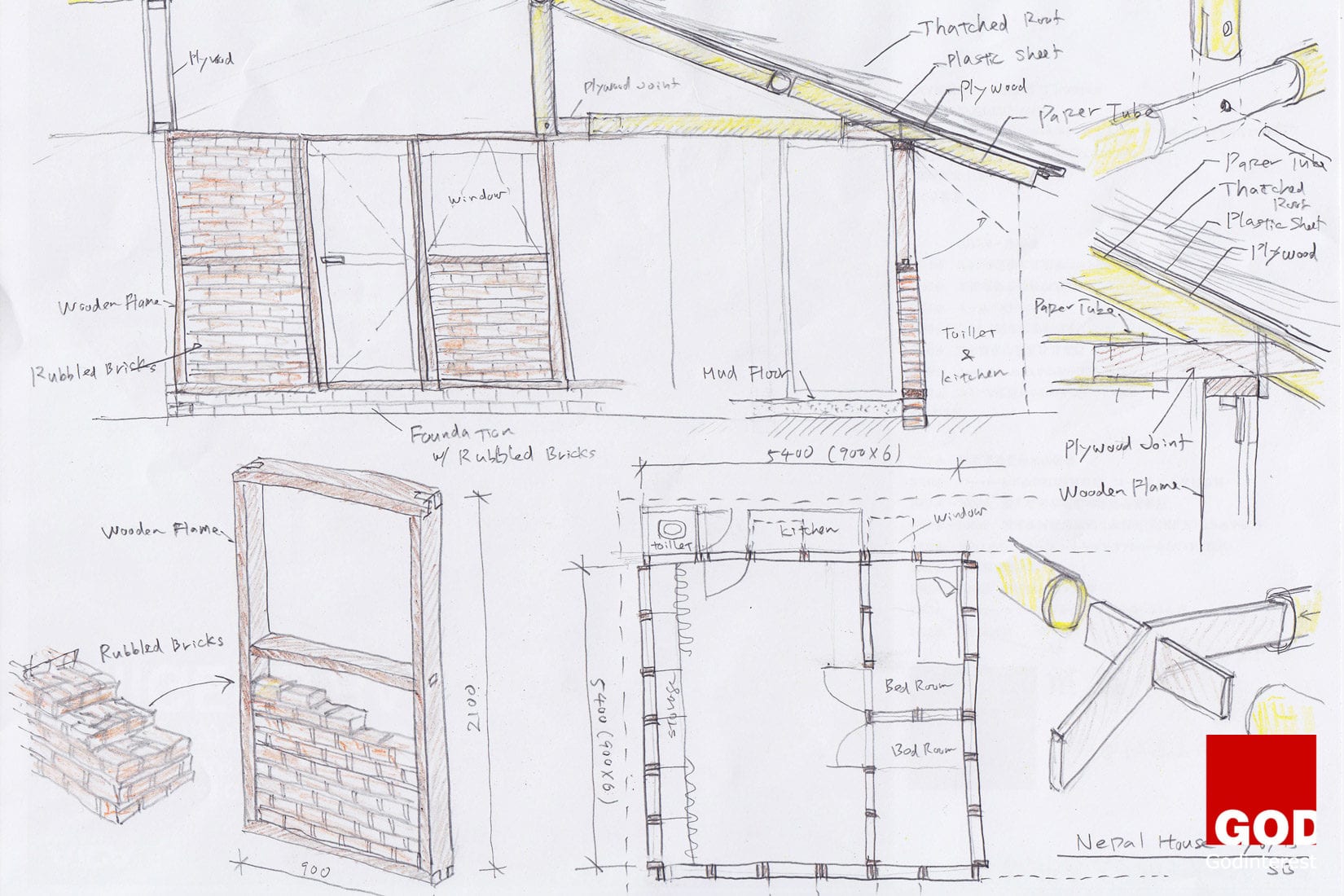

2. Housing for Nepal earthquake victims, Shigeru Ban, 2015
Simple, traditional homes in Nepal were the ones that withstood the catastrophic earthquake in 2015. As a result, Pritzker Prize-winning, disaster-relief architect Shigeru Ban designed housing structures for the victims.
Ban’s modular housing concept is modelled on the traditional homes that survived the earthquake. His design uses wood frames for the structure, cardboard tubes for the truss system of the roof, and debris from the disaster as infill for the wall. Thatch and plastic sheeting provided an extra layer of protection on the rooftop.

3. Women’s Centre in Darya Khan, Pakistan, Yasmeen Lari, 2011
Pakistani architect Yasmeen Lari (the first woman architect in Pakistan) showcases architecture’s role and influence in society. Throughout her career, the 75-year-old designer has built over 36,000 homes for earthquake and flood victims throughout Pakistan. She is also the founder of Heritage Foundation of Pakistan, which allows architecture students to train local residents to rebuild their homes and communities after a disaster using natural resources like bamboo and mud.
One of her well-known projects includes the Women’s Centre in Darya Khan, Pakistan. Lari holds a deep affection for Pakistani women, who are typically displaced and struggling with the care of their children following a natural disaster. The layout allows women to unite and socialize and keep their children safe. And in the event of a flood striking, the first floor is high enough so that waters cannot reach it.

4. Post-tsunami sustainability plan for Constitución, Chile, Elemental, 2014
After 2010’s deadly earthquake shook the coastal cities of Chile, plans for rebuilding and protecting cities like Constitución became a priority. In an effort to work with nature and the community, Pritzker Prize-winning architect Alejandro Aravena’s firm Elemental, proposed the intriguing method to plant more trees along the coast to absorb waters and prevent flooding.
The idea is that there is an opportunity to do something that would have long-term positive impacts, rather than a temporary fix that might be ruined by another major earthquake or tsunami in the area. The project will hopefully address short-term needs as well as potential long-term problems.

Resist. Delay. Store. Discharge. A Comprehensive Urban Water Strategy

5. Rebuilding of Hoboken, New Jersey after Hurricane Sandy, OMA, 2012
Following the disastrous Hurricane Sandy that struck the Northeastern United States in 2012, about 80 percent of Hoboken, New Jersey homes were flooded, leaving the community wondering how to rebuild itself with an emphasis on flood defense.
That’s when Dutch architect Rem Koolhaas’ firm OMA offered a solution that would combine hard infrastructure and soft landscaping, integrating coastal defense and natural drainage to protect against future flooding. The ideas between OMA’s and Elemental’s projects are very similar in that they look to work with nature rather than avoiding it.
Fernie told Dezeen that OMA offers a multi-pronged approach: resist, delay, restore and discharge. It acknowledges the complex water system and works with it, he said.








